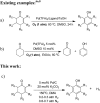Reaction-activated palladium catalyst for dehydrogenation of substituted cyclohexanones to phenols and H2 without oxidants and hydrogen acceptors
- PMID: 29142706
- PMCID: PMC5667403
- DOI: 10.1039/c5sc01044f
Reaction-activated palladium catalyst for dehydrogenation of substituted cyclohexanones to phenols and H2 without oxidants and hydrogen acceptors
Abstract
It is widely believed that the dehydrogenation of organic compounds is a thermodynamically unfavorable process, and thus requires stoichiometric oxidants such as dioxygen and metal oxides or sacrificial hydrogen acceptors to remove the hydrogen from the reaction mixture to drive the equilibrium towards the products. Here we report a previously unappreciated combination of common commercial Pd/C and H2 which dehydrogenates a wide range of substituted cyclohexanones and 2-cyclohexenones to their corresponding phenols with high isolated yields, with H2 as the only byproduct. The reaction requires no oxidants or hydrogen acceptors because instead of removing the generated hydrogen with oxidants or hydrogen acceptors, we demonstrated it can be used as a cocatalyst to help power the reaction. This method for phenol synthesis manifests a high atom economy, and is inherently devoid of the complications normally associated with oxidative dehydrogenations.
Figures




Similar articles
-
Aerobic dehydrogenation of cyclohexanone to cyclohexenone catalyzed by Pd(DMSO)2(TFA)2: evidence for ligand-controlled chemoselectivity.J Am Chem Soc. 2013 Jun 5;135(22):8205-12. doi: 10.1021/ja4031648. Epub 2013 May 24. J Am Chem Soc. 2013. PMID: 23662700 Free PMC article.
-
Palladium-Catalyzed Aerobic Dehydrogenation of Cyclic Hydrocarbons for the Synthesis of Substituted Aromatics and Other Unsaturated Products.ACS Catal. 2016 Dec 2;6(12):8201-8213. doi: 10.1021/acscatal.6b02406. Epub 2016 Oct 24. ACS Catal. 2016. PMID: 28154785 Free PMC article.
-
Palladium-catalyzed aerobic dehydrogenation of substituted cyclohexanones to phenols.Science. 2011 Jul 8;333(6039):209-13. doi: 10.1126/science.1204183. Epub 2011 Jun 9. Science. 2011. PMID: 21659567 Free PMC article.
-
Catalytic dehydrogenative aromatization of cyclohexanones and cyclohexenones.Org Biomol Chem. 2018 Nov 21;16(45):8662-8676. doi: 10.1039/c8ob02351d. Org Biomol Chem. 2018. PMID: 30379180 Review.
-
Palladium-Catalyzed Oxidation Reactions of Alkenes with Green Oxidants.ChemSusChem. 2019 Jul 5;12(13):2911-2935. doi: 10.1002/cssc.201900397. Epub 2019 Jun 24. ChemSusChem. 2019. PMID: 30989816 Review.
Cited by
-
Dehydrogenation and Transfer Hydrogenation of Alkenones to Phenols and Ketones on Carbon-Supported Noble Metals.ACS Catal. 2024 Feb 9;14(5):2883-2896. doi: 10.1021/acscatal.3c04849. eCollection 2024 Mar 1. ACS Catal. 2024. PMID: 38449532 Free PMC article.
-
Catalytic Aerobic Dehydrogenation of Nitrogen Heterocycles Using Heterogeneous Cobalt Oxide Supported on Nitrogen-Doped Carbon.Org Lett. 2015 Sep 18;17(18):4404-7. doi: 10.1021/acs.orglett.5b01790. Epub 2015 Sep 2. Org Lett. 2015. PMID: 26333043 Free PMC article.
-
Discovery and bioinspired total syntheses of unprecedented sesquiterpenoid dimers unveiled bifurcating [4 + 2] cycloaddition and target differentiation of enantiomers.Chem Sci. 2023 Nov 29;15(4):1260-1270. doi: 10.1039/d3sc05233h. eCollection 2024 Jan 24. Chem Sci. 2023. PMID: 38274075 Free PMC article.
-
Library construction of stereochemically diverse isomers of spirooliganin: their total synthesis and antiviral activity.Chem Sci. 2021 Apr 10;12(20):7003-7011. doi: 10.1039/d1sc01277k. Chem Sci. 2021. PMID: 34123328 Free PMC article.
-
Versatile routes for synthesis of diarylamines through acceptorless dehydrogenative aromatization catalysis over supported gold-palladium bimetallic nanoparticles.Chem Sci. 2017 Mar 1;8(3):2131-2142. doi: 10.1039/c6sc04455g. Epub 2016 Dec 1. Chem Sci. 2017. PMID: 28507665 Free PMC article.
References
-
- Tyman J. H. P., Synthetic and Natural Phenols, Elsevier, New York, 1996.
- Rappoport Z., The Chemistry of Phenols, Wiley-VCH, New York, 2003.
-
- Maleczka Jr R. E., Shi F., Holmes D., Smith M. R. J. Am. Chem. Soc. 2003;125:7792. - PubMed
- Guo Z., Schultz A. G. Org. Lett. 2001;3:1177. - PubMed
- Lee D. H., Kwon K. H., Yi C. S. J. Am. Chem. Soc. 2012;134:7325. - PubMed
- Bedford R. B., Coles S. J., Hursthouse M. B., Limmert M. E. Angew. Chem., Int. Ed. 2003;42:112. - PubMed
- Truong T., Daugulis O. Chem. Sci. 2013;4:531. - PMC - PubMed
- Ciana C. L., Phipps R. J., Brandt J. R., Meyer F. M., Gaunt M. J. Angew. Chem., Int. Ed. 2011;50:458. - PubMed
- Fujimoto K., Tokuda Y., Maekawa H., Matsubara Y., Mizuno T., Nishiguchi I. Tetrahedron. 1996;52:3889.
-
- Fyfe C. A., The Chemistry of the Hydroxyl Group, Wiley-Interscience, New York, 1971, pp. 83–127.
- Hoarau C., Pettus T. R. R. Synlett. 2003:127. - PMC - PubMed
- Hanson P., Jones J. R., Taylor A. B., Walton P. H., Timms A. W. J. Chem. Soc., Perkin Trans. 2. 2002:1135.
- George T., Mabon R., Sweeny G., Sweeney J. B., Tavassoli A. J. J. Chem. Soc., Perkin Trans. 1. 2000:2529.
-
- Hashmi A. S. K., Frost T. M., Bats J. W. J. Am. Chem. Soc. 2000;122:11553.
-
- Ackermann L., Kapdi A. R., Fenner S., Kornhaaß C., Schulzke C. Chem.–Eur. J. 2011;17:2965. - PubMed
LinkOut - more resources
Full Text Sources
Other Literature Sources

